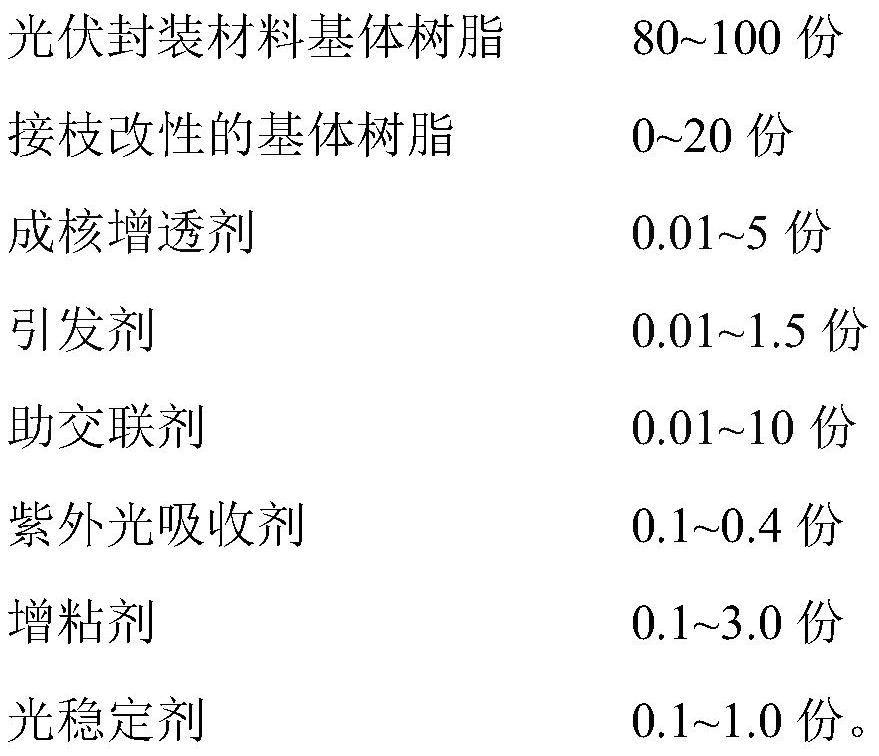A high transmittance photovoltaic encapsulation material using nucleating antireflection agent
A packaging material, high light transmittance technology, applied in photovoltaic power generation, adhesives, adhesive additives, etc., can solve the long-term UV resistance and mechanical properties of EVA film, the high price of graphene oxide nanometer, affects the long-term reliability of components to improve the photoelectric conversion efficiency, shorten the molding cycle, and increase the strength
- Summary
- Abstract
- Description
- Claims
- Application Information
AI Technical Summary
Problems solved by technology
Method used
Image
Examples
Embodiment 1
[0023] This embodiment provides a photovoltaic encapsulation material with high light transmittance.
[0024] In this example, by mass fraction, the VA mass content of 100 mass parts is the ethylene-vinyl acetate copolymer of 28%, adds the cadmium sulfide of 0.5 mass part, the tert-butyl peroxyisopropyl carbonate of 1 mass part, 5 parts by mass of trimethylolpropane triacrylate, 1 part by mass of KH550, 0.1 part by mass of 2-hydroxy-4-n-octyloxybenzophenone, 0.1 part by mass of bis-2,2,6 sebacic acid ,6-tetramethylpiperidinol ester. Mix evenly, and the above mixture is pre-mixed, melt-extruded, cast into a film, cooled, slitting and winding to obtain the photovoltaic encapsulation material, which is denoted as E-1.
Embodiment 2
[0026] This embodiment provides a photovoltaic encapsulation material with high light transmittance.
[0027] In this example, in terms of mass fractions, 90 parts by mass of ethylene-vinyl acetate copolymer with a mass content of VA of 26% is added, and 10 parts by mass of the above-mentioned ethylene-vinyl acetate copolymer (with a mass content of VA of 26%) and Cadmium selenide blended and granulated masterbatch at 5 wt%, 1 mass part of tert-butyl peroxyisopropyl carbonate, 5 mass parts of trimethylolpropane triacrylate, 2 mass parts of KH550, 0.4 mass parts 2-Hydroxy-4-n-octyloxybenzophenone, 1 part by mass of bis-2,2,6,6-tetramethylpiperidinol sebacate. Mix evenly, and the above mixture is pre-mixed, melt-extruded, cast into a film, cooled, slitting and winding to obtain the photovoltaic packaging material, which is designated as E-2.
Embodiment 3
[0029] This embodiment provides a photovoltaic encapsulation material with high light transmittance.
[0030]In this example, in terms of mass fractions, 90 parts by mass of ethylene-vinyl acetate copolymer with a mass content of VA of 20%, 10 parts by mass of ethylene-vinyl acetate copolymer with a mass content of 20% are grafted with methyl Acrylic anhydride (graft rate 10%), adding 5 mass parts of zinc sulfide, 1.5 mass parts of tert-butyl peroxide 3,3,5-trimethylhexanoate, 10 mass parts of pentaerythritol triacrylate, 3 mass parts 0.2 parts by mass of KH550, 0.2 parts by mass of 2-hydroxy-4-n-octyloxybenzophenone, and 0.5 parts by mass of bis-2,2,6,6-tetramethylpiperidinol sebacate. Mix evenly, and the above mixture is pre-mixed, melt-extruded, cast into a film, cooled, slitting and winding to obtain the photovoltaic packaging material, which is marked as E-3.
PUM
| Property | Measurement | Unit |
|---|---|---|
| particle diameter | aaaaa | aaaaa |
| particle diameter | aaaaa | aaaaa |
| particle diameter | aaaaa | aaaaa |
Abstract
Description
Claims
Application Information
 Login to View More
Login to View More - R&D
- Intellectual Property
- Life Sciences
- Materials
- Tech Scout
- Unparalleled Data Quality
- Higher Quality Content
- 60% Fewer Hallucinations
Browse by: Latest US Patents, China's latest patents, Technical Efficacy Thesaurus, Application Domain, Technology Topic, Popular Technical Reports.
© 2025 PatSnap. All rights reserved.Legal|Privacy policy|Modern Slavery Act Transparency Statement|Sitemap|About US| Contact US: help@patsnap.com

